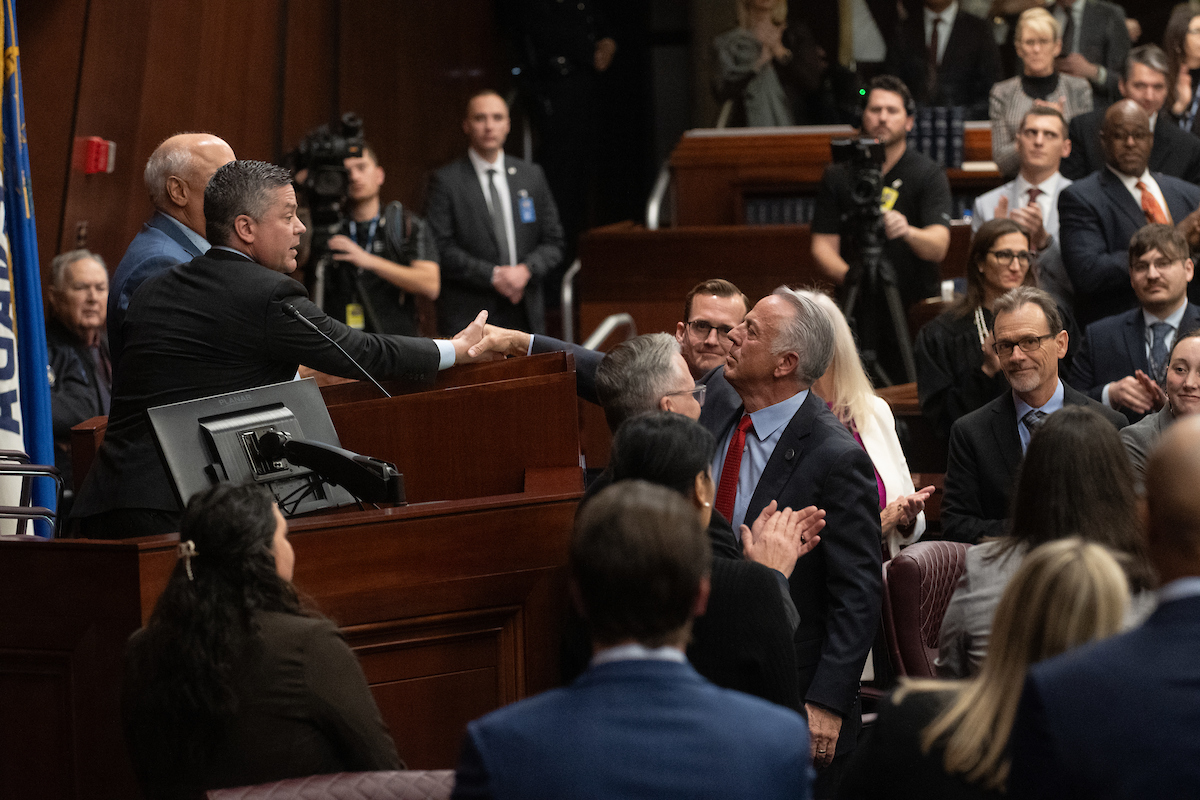How Lombardo’s office eliminated its budget deficit

On the night of Gov. Joe Lombardo’s State of the State address last month, Democratic legislative leaders accused the Republican governor of submitting a budget with a $335 million structural deficit.
Three weeks later (and two weeks after the governor’s office conceded the shortfall existed), the deficit has been eliminated after the governor’s office made changes to how some programs were funded and incorporated certain items that were left out of original revenue projections.
The resolution was presented at a Wednesday joint budget meeting, during which governor’s office officials, facing questions from frustrated Democratic legislators, admitted that there were myriad errors that emerged while staff were crafting the budget, including miscalculations and missing appropriations. They admitted that this was in part because they were new to their roles.
“There was things I saw in that budget that I would have never even allowed,” said Tiffany Greenameyer, the director of the governor’s finance office, who assumed her role immediately after the deficit was discovered.
And future changes will be coming — now that the structural deficit has been eliminated, state lawmakers will spend their 120-day session reviewing it, suggesting changes and then sending it back to Lombardo for his signature or veto.
Here’s a closer look at what the problems were — and how they were fixed.
The Economic Forum — a panel of private-sector economists whose projections set the size of the state budget — determined in December that Lombardo and the Legislature could spend about $12.4 billion across the next two years.
However, Lombardo’s budget called for $335 million more than that in operating expenses, meaning he was proposing to spend more money than the state was projected to have available. These operating expenses are for ongoing purposes, such as salaries, rather than one-time appropriations that would have to be re-evaluated in future legislative sessions.
Democratic legislators were particularly concerned about the future of initiatives that are one-shot appropriations. But governor’s office officials said they intended to continue funding those programs through future revenues that would be brought in, mostly from Medicaid savings — a pledge that Democrats cast doubt on in light of Lombardo’s promise not to raise taxes this session.
“Serious fiscal responsibility requires more than a hope and a prayer that the state will have more money in the future. It requires the discipline to propose a budget now that doesn’t come with the high risk of screwing over Nevadans in the future,” Assembly Speaker Steve Yeager (D-Las Vegas) told The Nevada Independent.
It is common for a proposed budget to require changes, but longtime state budget observers have said the size of such a deficit — at 2.5 percent of the budget — is unprecedented.
To eliminate the deficit, the governor’s office made changes on increasing the amount of available revenue across the next two years, while also cutting down on expenses using ongoing funding — preferred because it would already be baked into future budgets.
Achieving the former was simple. When the size of the deficit was calculated, it did not include the estimated $150 million in revenue that comes from money that will be appropriated, but not used, by state agencies. These funds typically come from money that is budgeted but not spent on payroll, usually because of vacancies — and the amount of excess money will likely be much more than the $150 million if past years are any indication.
“I anticipate that you're going to see a lot more salary adjustment dollars coming back,” Greenameyer said.
This change shrunk the deficit by nearly half. But the governor’s office had to also slightly reduce its amount of revenue available because the original budget did not account for $24 million in tax credits for child care facilities (a priority of Lombardo’s) and about $6 million in tax credits given to business that donate to Opportunity Scholarships, the program that provides private school scholarships to students from low- and middle-income households.
Cutting down on operating expenses was a bit more complex. To do so, the governor’s office changed the funding mechanism for certain initiatives, and adjusted the implementation plan of some programs — while also maintaining that these changes did not result in the elimination of any programs, positions or services.
Most notably, the governor’s office changed the $140 million in funding to continue state-funded pre-K from an ongoing expenditure to a one-time appropriation.
Democratic leaders raised concerns about this decision at the top of the meeting.
“Are we to take this to mean that there's not a long-term commitment for this program, or is it we want to sort of see how this works out?” Yeager said.
Ryan Cherry, Lombardo’s chief of staff, said the governor’s office intended to fund pre-K through operating expenses, but that the deficit prompted them to fund it through one-shot appropriations, just as was approved in the 2023 legislative session, which was the first year that the funding occurred.
He added that the governor’s office intends to build the program into the base of the budget once more revenue comes in through Medicaid savings.
The governor’s team also changed the $57 million in cost-of-living adjustments for Nevada System of Higher Education employees to a one-shot appropriation, and did the same for $17 million in funding for charter school transportation and $13 million for a program to provide financial assistance for aspiring educators.
Designating funding as an operating expense, rather than a one-shot appropriation, is typically preferred because the money would already be included in future budgets. One-shot spending comes with uncertainty, including in 2023, when debate about the permanence of Legislature-approved teacher raises threw a wrench in teachers union negotiations.
Elsewhere, the governor’s office changed the revenue source for an assessment and placement center at the Summit View Youth Center, delayed the rollout of an adult dental program and made various revenue changes related to the Nevada Health Authority (a proposed new agency combining several public health insurance programs) that resulted in savings of $117 million.
Finally, in another change unrelated to the structural deficit, the governor’s office fixed budget errors related to one-shot appropriations made during the 2023 legislative session.
Lombardo’s budget had incorrectly moved this funding — which included $90 million for a homeless service campus and $14 million in construction cost for the Athletics’ stadium — to the general fund to be used for other purposes, which is prohibited. However, those errors have been fixed, and these allocations will continue as one-shot appropriations over the next two years.
